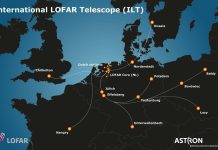
For decades, astronomers have believed that most of the universe is made of mysterious substances called dark matter and dark energy.
According to the standard view, only a small fraction of the cosmos is made of the familiar matter that forms stars, planets, and people.
The rest—about 95%—is thought to be this invisible, unknown “stuff.”
But a new study suggests that neither dark matter nor dark energy may actually exist. Instead, what scientists see as these mysterious forces could simply be an illusion, created by the slow weakening of nature’s basic forces as the universe ages.
The research comes from Rajendra Gupta, an adjunct professor in the Department of Physics at the University of Ottawa.
His study, published in the journal Galaxies, argues that if constants like gravity gradually change over time and across space, they can explain the puzzling phenomena that astronomers have struggled with for decades—such as why galaxies spin faster than expected and why the universe’s expansion is speeding up.
Gupta explains that as the universe expands, the fundamental forces that govern it actually get weaker on average.
This weakening makes it look like some mysterious push—labeled “dark energy”—is driving the cosmos to expand faster.
On smaller scales, such as within galaxies or galaxy clusters, changes in these forces mimic the extra gravity that scientists usually attribute to dark matter. In other words, there may be no need to imagine hidden particles or invisible energy; the changes could simply be the natural result of an evolving universe.
What makes Gupta’s proposal stand out is that it uses the same equation to explain both cosmic-scale and galaxy-scale phenomena. In the traditional model, two separate explanations are needed: dark energy for the expansion of the universe, and dark matter for the way galaxies behave. Gupta’s model claims to unify them, removing the need for both.
In his earlier work, Gupta challenged the idea of dark matter at the cosmological scale. Now, in his latest study, he has applied his theory to the astrophysical scale—specifically to the way galaxies rotate.
Astronomers have long puzzled over why stars in the outer regions of galaxies move just as fast as those closer to the center, when gravity from visible matter should make them slow down.
The standard explanation has been that galaxies are surrounded by invisible “halos” of dark matter.
Gupta’s model, however, suggests that this effect is caused by a parameter he calls α, which changes with the distribution of ordinary matter like stars, gas, and planets. Where there is little visible matter, α creates extra gravitational pull, mimicking dark matter’s effect.
This new perspective could also solve another cosmic mystery: how galaxies and black holes in the early universe grew so quickly.
Gupta’s model effectively stretches the timeline of cosmic history, nearly doubling the age of the universe. That gives stars, galaxies, and black holes much more time to form and grow, making their existence far less puzzling.
If this theory holds up, it could transform modern astronomy. It even suggests that the global search for dark matter particles, which has cost billions of dollars, might be chasing a ghost.
Even if exotic particles are eventually detected, Gupta argues, they would not explain the majority of the effects scientists have attributed to dark matter.
“Sometimes the simplest explanation is the best one,” Gupta says. “Maybe what we call dark matter and dark energy are just tricks played by the evolving constants of nature.”



